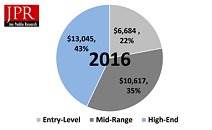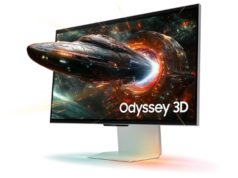Jon Peddie Research (JPR), one of the most regarded research and consulting firms for graphics and multimedia, today announced that the global PC Gaming Hardware market has breached the $30 billion mark for the first time (let that sink in for a moment).
Comprised of pre and DIY built gaming computers, upgrades, and accessories such as input devices and audio/communication systems, the market exceeded $30 billion in 2016 and is forecast to grow at a 6% CAGR (compound annual growth rate) through 2019. Due of an entrenched PC gaming culture, large population, and a lack of significant console traction, the Asia Pacific Region is noted as leading the world in both growth and market size with a forecasted 7% CAGR to 2019 from a TAM (total addressable market) of almost $11.3 billion in 2016. However, North America and Western Europe both individually lead Asia Pacific for High-End hardware, albeit at lower growth rates of 5.78% and 6.63% vs. 9.61% respectively. The western appetite for PC gaming systems costing thousands of dollars is indeed strong (though we didn’t need a JPR report to tell us that, now did we?).

Ted Pollak, Senior Game Industry Analyst for JPR said “Global consumers continue to embrace the PC platform for video games due to multiple factors. The desktop ergonomic is popular because the display distance offers increased detail when using HD and UHD monitors. Additionally there is superior control with mouse and keyboard control interfaces. This has been validated with eSports overwhelmingly being played on PCs. Additionally, product designers have given PC gamers thousands of options for complete customization from a functionally and aesthetic perspective. Examples of this include dedicated driving and flight systems, multi-display setups, super-powerful graphics boards, and a wide selection of gaming notebooks ranging from desktop substitutes to innovative “thin and light” offerings. Liquid cooling, lighting, solid state drives, genre specific gaming mice, mechanical keyboards, notebook graphics amplifiers, and Xbox accessory compatibility offer gamers more choices than they have ever had.”
JPR has renamed the three segments of hardware it tracks to Entry-Level, Mid-Range, and High-End (from Mainstream, Performance, and Enthusiast). Jon Peddie, President of JPR said “We know that gamers with lower budgets are just as passionate about gaming as those with more resources and are enthusiasts in the purest sense of the word, so we decided to transition to a more descriptive terminology. Nvidia and AMD are not ignoring these customers either and offerings like the GTX 1050 bring powerful graphics processing for around $120. We are also very excited about the prospects for the AMD Ryzen CPU platform and think it will be adopted at all three hardware tiers. Of course Intel CPUs currently offer superior power and value for gamers of every budget level, and their integrated graphics now rival game consoles.”
Part of the phenomena JPR observes is that the ranks of PC gamers are growing in the Mid and High-End (where average selling prices tend to be high). Additionally, JPR notes that the average PC sale is increasingly motivated by video game usage, which is the primary driving factor for sales in an otherwise stagnant or declining PC market. As basic computing functions become more entrenched with mobile devices, the PC ultimately becomes a power user’s tool, whether for gaming, photo and video editing or content creation.Source: Jon Peddie Research






![[Exploring Good Lock ②] Unveiling the Most Popular Good Lock](https://loginby.com/itnews/wp-content/uploads/2025/04/Exploring-Good-Lock-②-Unveiling-the-Most-Popular-Good-Lock-100x75.gif)